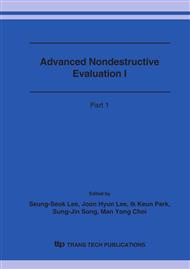p.1431
p.1435
p.1439
p.1443
p.1447
p.1451
p.1457
p.1461
p.1465
A Study of the Quantitative Nondestructive Evaluation Using the Cross Type Magnetic Source and the Magnetic Camera
Abstract:
The magnetic camera using magnetic lens is proposed to satisfy the demands such as obtaining the distribution of the magnetic flux leakage (DMFL) on the high lift-off, and improving sensitivity. However, DMFL is strongly affected by the magnetization direction. Therefore, the DMFL has low intensity when the crack is not perpendicular to the magnetizing direction. Also, quantitative nondestructive evaluation would be difficult. This paper proposes an improved magnetization method to evaluate a crack quantitatively, regardless of the crack direction. The secondary magnetic source, which is perpendicular to the primary magnetic source, is introduced in the scan type magnetic camera. The intensity of two values of ∂B/∂x (1st differential to the magnetization direction) of the DMFL can be used to evaluate the crack volume. The experimental and the numerical analysis results are considered to verify this phenomenon.
Info:
Periodical:
Pages:
1447-1450
Citation:
Online since:
October 2006
Authors:
Price:
Сopyright:
© 2006 Trans Tech Publications Ltd. All Rights Reserved
Share:
Citation:


